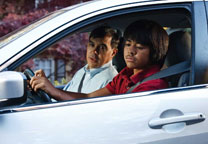Eight Danger Zones
Eight teens a day are killed in car crashes. Make sure your young driver is aware of the leading causes of teen crashes, and put rules in place to help your teen stay safe.
- No. 1: Driver inexperience. Most crashes happen during the first year a teen has a license. Provide at least 30 to 50 hours of supervised driving practice over at least six months. Make sure to practice on a variety of roads, at different times of day, and in varied weather and traffic conditions. This will help your teen gain the skills he or she needs to be safe.
- No. 2: Driving with teen passengers. Crash risk goes up when teens drive with other teens in the car. Follow your state’s teen driving law for passenger restrictions. If your state doesn’t have such a rule, limit the number of teen passengers your child can have to zero or one. Keep this rule for at least the first six months.
- No. 3: Nighttime driving. For all ages, fatal crashes are more likely to occur at night; but the risk is highest for teens. Make sure your teen is off the road by 9 or 10 p.m. for at least the first six months of licensed driving.
- No. 4: Not using seat belts. The simplest way to prevent car crash deaths is to buckle up. Require your teen to wear a seat belt on every trip. This simple step can reduce your teen’s risk of dying or being badly injured in a crash by about half.
- No. 5: Distracted driving. Distractions increase your teen’s risk of being in a crash. Don’t allow activities that may take your teen’s attention away from driving, such as talking on a cell phone, texting, eating, or playing with the radio.
- No. 6: Drowsy driving. Young drivers are at highest risk for drowsy driving, which causes thousands of crashes every year. Teens are most tired and at risk when driving in the early morning or late at night. Be sure your teen is fully rested before he or she gets behind the wheel.
- No. 7: Reckless driving. Research shows that teens lack the experience, judgment, and maturity to assess risky situations. Help your teen avoid the following unsafe behaviors.
- Speeding: Make sure your teen knows to follow the speed limit and adjust speed to road conditions.
- Tailgating: Remind your teen to maintain enough space behind the vehicle ahead to avoid a crash in case of a sudden stop.
- Insufficient scanning: Stress the importance of always knowing the location of other vehicles on the road.
- No. 8: Impaired driving. Even one drink will impair your teen’s driving ability and increase the risk of a crash. Be a good role model: don’t drink and drive, and reinforce this message with your teen.

Spread the Word
Take the next step by sharing this information on Facebook and Twitter.
Download or Order Free Copies
Contact Us:
- Centers for Disease Control and Prevention
National Center for Injury Prevention and Control (NCIPC)
4770 Buford Hwy, NE
MS F-63
Atlanta, GA 30341-3717 - 800-CDC-INFO
(800-232-4636)
TTY: (888) 232-6348
New Hours of Operation:
8am-8pm ET/
Monday-Friday
Closed Holidays - cdcinfo@cdc.gov





